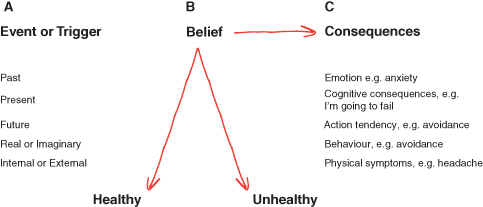Theoretical Perspectives on Cognitive Behaviour Therapy
Albert Ellis and Aaron Beck
At the beginning of the book, we touched on the two pioneers of CBT, Albert Ellis and Aaron Beck. We will now briefly explain the two main schools of Cognitive Behaviour Therapy. Both have a scientific theory that can be, and has been, tested as well as a structured framework and process of therapy.
The Ellis Model
Rational Emotive Behaviour Therapy was founded in 1955 by Albert Ellis and has the longest history of any of the cognitive behaviour therapies. This book has focused on using Ellis’s model because of its humanistic robust theory and philosophical basis.
REBT, as covered in the book, can be conceptualised by the ABC diagram below, where it is not the event, but the belief or view you hold about the event, which is at the heart of emotional states.
CBT, Event, Belief, Consequences Diagram

Ellis’s REBT is about helping people to:
It helps us develop resiliency and self acceptance by enabling us to face our disturbances full on rather than ignoring them through distraction and avoidance. This can lead to a powerful philosophical shift which focuses us on our desires, wants and wishes without becoming disturbed about our past, present or future setbacks. We learn to view setbacks and failures as purely temporary as opposed to life or soul destroying, while remaining motivated and focused on our desires and goals.
The Beck Model
Beck’s model is called Cognitive Therapy (CT). It says that our emotions and behaviour are influenced by the way we think and by how we make sense of the world. Our interpretations and assumptions developed from personal experience often conflict with the real world. Beck encouraged his patients to focus their attention on their ‘automatic thoughts’.
Clients are helped to test their assumptions and views of the world in order to check if they fit with reality. When clients learn that their perceptions and interpretations are distorted or unhelpful they then work at correcting them.
Differences between the Ellis and Beck Models
Both schools are open to influence from each other and, in practice, ideas from both can be utilised, as appropriate, to achieve successful outcomes for clients. However, they remain distinct. The main distinctions are i) testing assumptions and ii) philosophical basis.
Testing Assumptions
In Ellis’s model the client’s assumptions are assumed to be true and are not immediately put to a reality test. In Beck’s model the client’s assumptions are tested for validity first. The reason for this is that REBT theory states that a client’s assumptions are a consequence of holding unhealthy beliefs, so these assumptions are assumed to be true in order to ‘cut to the chase’ and identify the unhealthy beliefs.
Treating Symptoms or Generalised Philosophy?
Beck’s model is based on the treatment of the symptom. REBT treats the symptom but its aim is to effect ‘profound philosophic change and a radically new outlook on life’ (Albert Ellis) by transforming deeply held core beliefs about the self, others and the world.
However, a drawback to REBT may be that some people may not like its direct approach. Beck’s model is more cautious and aims for some kind of improvement and return to normal functioning, symptom relief or symptom management. On the negative side, this approach misses the chance to offer people a simple philosophy and the tools to become their own therapists when faced with different problems in the future. Our preference is REBT.
Ellis or Beck? That is the Question …
Both were great thinkers and have made an enormous contribution to the understanding and application of psychological health.